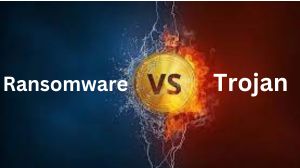In the ever-evolving landscape of cybersecurity, threats continue to proliferate, posing significant risks to individuals, businesses, and governments alike. Ransomware vs Trojan, employing different tactics to compromise systems and data.
This article delves into the intricate details of ransomware and Trojans, exploring their characteristics, mechanisms, and the evolving nature of cyber threats.
Contents
Understanding Ransomware
Ransomware is a type of malicious software designed to encrypt files on a victim’s system, rendering them inaccessible. Perpetrators then demand a ransom, usually in cryptocurrency, in exchange for providing the decryption key. This form of cyber extortion has gained notoriety due to its ability to cripple entire organizations and its lucrative nature for cybercriminals.
Characteristics of Ransomware
- Encryption-Based Attacks: Ransomware operates by employing robust encryption algorithms to lock victims’ files. This renders the files unreadable and essentially holds them hostage until the ransom is paid.
- Social Engineering Tactics: Ransomware often relies on social engineering techniques to trick users into clicking on malicious links or downloading infected attachments. Phishing emails and fraudulent websites are common vectors for distributing ransomware.
- Wide-Spread Impact: Ransomware attacks can have widespread consequences, affecting individuals, businesses, and even critical infrastructure. High-profile incidents have demonstrated the potential for massive disruptions and financial losses.
- Cryptocurrency Payments: Ransom payments are typically demanded in cryptocurrencies, such as Bitcoin, to ensure the anonymity of the attackers. This complicates law enforcement efforts to trace and apprehend the culprits.
Understanding Trojans
A Trojan, short for Trojan Horse, derives its name from the ancient Greek story of a deceptive wooden horse used to infiltrate a fortified city. Similarly, a Trojan in the digital realm disguises itself as legitimate software to gain unauthorized access to a system.
Characteristics of Trojans
- Disguised Nature: Trojans masquerade as benign or useful software to deceive users into installing them. They often come bundled with seemingly harmless programs, making it challenging for users to detect their presence.
- Backdoor Access: Once installed, Trojans create a backdoor, enabling remote access for cybercriminals. This unauthorized access can lead to data theft, surveillance, or the installation of additional malicious software.
- Diverse Functions: Trojans are versatile and can perform a range of malicious activities beyond unauthorized access. This includes data theft, keylogging, and even facilitating the distribution of other malware.
- Persistence: Trojans often exhibit persistence by embedding themselves deeply within the system. They may attempt to avoid detection by antivirus software and maintain their presence for extended periods.
Comparative Analysis of Ransomware vs Trojan
- Objective: Ransomware focuses on encrypting files to demand a ransom, while Trojans prioritize gaining unauthorized access and executing various malicious activities beyond encryption.
- Monetary Motivation: Ransomware is driven by financial gain through ransom payments, whereas Trojans may be used for a broader range of purposes, including espionage, data theft, or as a delivery mechanism for other malware.
- Visibility: Ransomware attacks are often immediately noticeable as files become inaccessible, while Trojans aim to operate stealthily, remaining undetected for extended periods to maximize their impact.
- Prevention and Mitigation: Both ransomware and Trojans require robust cybersecurity measures, including regular software updates, employee training, and the use of antivirus and anti-malware tools. Backup systems are crucial for mitigating the impact of ransomware attacks.
Conclusion
In the dynamic world of cybersecurity, the threats posed by ransomware and Trojans demand constant vigilance and adaptive defense strategies. Understanding the characteristics, mechanisms, and motives behind these malicious entities is essential for individuals and organizations seeking to protect their digital assets.
As technology continues to advance, so too will the sophistication of cyber threats, emphasizing the importance of proactive cybersecurity measures to safeguard against the evolving landscape of ransomware and Trojan attacks.

